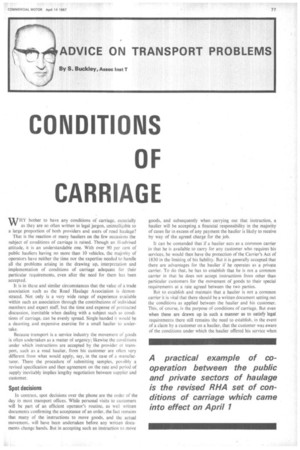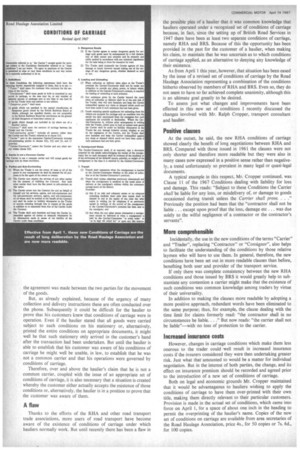CONDITIONS OF CARRIAGE
Page 79

Page 80

If you've noticed an error in this article please click here to report it so we can fix it.
WHY bother to have any conditions of carriage, especially
as they are so often written in legal jargon, unintelligible to a large proportion of both providers and users of road haulage?
That is the reaction of many hauliers on the few occasions the subject of conditions of carriage is raised. Though art ill-advised attitude, it is an understandable one. With over 90 per cent of public hauliers having no more than 10 vehicles, the majority of operators have neither the time nor the expertise needed to handle all the problems arising in the drawing up, interpretation and implementation of conditions of carriage adequate for their particular requirements, even after the need for them has been accepted.
It is in these and similar circumstances that the value of a trade association such as the Road Haulage Association is demonstrated. Not only is a very wide range of experience available within such an association through the contributions of individual members and expert staff, but the time and expense of protracted discussion, inevitable when dealing with a subject such as conditions of carriage, can be evenly spread. Single-handed it would be a daunting and expensive exercise for a small haulier to undertake.
Because transport is a service industry the movement of goods is often undertaken as a matter of urgency; likewise the conditions under which instructions are accepted by the provider or transport, such as a road haulier, from his customer are often very different front what would apply, say, in the case of a manufacturer. There the procedure of submitting samples, possibly a revised specification and then agreement on the rate and period of supply inevitably implies lengthy negotiation between supplier and customer.
Spot decisions In contrast, spot decisions over the phone are the order of the day in most transport offices. While personal visits to customers will be part of an efficient operator's routine, as well written documents confirming the acceptance of an order, the fact remains that many of the instructions to move goods, and the actual movement, will have been undertaken before any written documents change hands. But in accepting such an instruction to move goods, and subsequently when carrying out that instruction, a haulier will be accepting a financial responsibility in the majority of cases far in excess of any payment the haulier is likely to receive by way of the agreed charge for the job.
It can be contended that if a haulier acts as a common carrier in that he is available to carry for any customer who requires his services, he would then have the protection of the Carrier's Act of 1830 in the limiting of his liability. But it is generally accepted that there are advantages for the haulier if he operates as a private carrier. To do that, he has to establish that he is not a common carrier in that he does not accept instructions from other than particular customers for the movement of goods to their special requirements at a rate agreed between the two parties.
But to establish and maintain that a haulier is not a common carrier it is vital that there should be a written document setting out the conditions as applied between the haulier and his customer. This, of course, is the purpose of conditions of carriage. But even when these are drawn up in such a manner as to satisfy legal requirements there still remains the need to establish, in the event of a claim by a customer on a haulier. that the customer was aware of the conditions under which the haulier offered his service when the agreement was made between the two parties for the movement of the goods.
But, as already explained, because of the urgency of many collection and delivery instructions these are often conducted over the phone. Subsequently it could be difficult for the haulier to prove that his customers knew that conditions of carriage were in operation. Even if the haulier stated that all goods were carried subject to such conditions on his stationery or, alternatively, printed the entire conditions on appropriate documents, it might well be that such stationery only arrived in the customer's hand after the transaction had been undertaken. But until the haulier is able to establish that his customer was aware of his conditions of carriage he might well be unable, in law, to establish that he was not a common carrier and that his operations were governed by conditions of carriage.
Therefore, over and above the haulier's claim that he is not a common carrier, coupled with the issue of an appropriate set of conditions of carriage, it is also necessary that a situation is created whereby the customer either actually accepts the existence of those conditions or, alternatively, the haulier is in a position to prove that the customer was aware of them.
A flaw
Thanks to the efforts of the RHA and other road transport trade associations, more users of road transport have become aware of the existence of conditions of carriage under which hauliers normally work. But until recently there has been a flaw in the possible plea of a haulier that it was common knowledge that hauliers operated under a recognized set of conditions of carriage because, in fact, since the setting up of British Road Services in 1947 there have been at least two separate conditions of carriage, namely RHA and BRS. Because of this the opportunity has been provided in the past for the customer of a haulier, when making his claim, to maintain that he was uncertain as to which conditions of carriage applied, as an alternative to denying any knowledge of their existence.
As from April 1 this year, however, that situation has been eased by the issue of a revised set of conditions of carriage by the Road Haulage Association representing a combination of the conditions hitherto observed by members of RHA and BRS. Even so, they do not seem to have so far achieved complete unanimity, although this is an ultimate goal greatly to be desired.
To assess just what changes and improvements have been effected in this new set of conditions I recently discussed the changes involved with Mr. Ralph Cropper, transport consultant and haulier.
Positive clauses
At the outset, he said, the new RHA conditions of carriage showed clearly the benefit of long negotiations between RHA and BRS. Compared with those issued in 1961 the clauses were not only shorter and therefore more readable but they were also in many cases now expressed in a positive sense rather than negatively, a trend unfortunately so prevalent in many legal or quasi-legal documents.
A typical example in this respect, Mr. Cropper continued, was Clause 11 of the 1967 Conditions dealing with liability for loss and damage. This reads: "Subject to these Conditions the Carrier shall be liable for any loss, or misdelivery of, or damage to goods occasioned during transit unless the Carrier shall prove. . ." Previously the position had been that the "contractor shall -not be liable . .. except upon proof that the loss, damage etc . . . was due solely to the wilful negligence of a contractor or the contractor's servants".
More comprehensible
Incidentally, the use in the new conditions of the terms "Carrier" and "Trader", replacing "Contractor" or "Consignor", also helps to facilitate the understanding of the conditions by those relative laymen who will have to use them. In general, therefore, the new conditions have been set out in more readable clauses than before, benefiting both user and provider of the transport service.
If only there was complete consistency between the new RHA conditions and those issued by BRS it would greatly help to substantiate any contention a carrier might make that the existence of such conditions was common knowledge among traders by virtue of their universality.
In addition to making the clauses more readable by adopting a more positive approach, redundant words have been eliminated to the same purpose; thus, for example, the clause dealing with the time limit for claims formerly read: "the contractor shall in no circumstances be liable. . . ." But now reads: "the carrier shall not be liable"—with no loss of protection to the carrier.
Increased insurance costs However, changes in carriage conditions which make them less onerous to the trader could well result in increased insurance costs if the insurers considered they were then undertaking greater risk, Just what that' amounted to would be a matter for individual negotiation. But in the interest of both parties, the change, and its effect on insurance premium should be recorded and agreed prior to the introduction of a new set of conditions of carriage.
Both on legal and economic grounds Mr. Cropper maintained that it would be advantageous to hauliers wishing to apply the conditions of carriage to have them over-printed with their own title, making them directly relevant to their particular customers. Provision is made in the actual set of conditions, which came into force on April 1, for a space of about one inch in the heading to permit the overprinting of the haulier's name. Copies of the new set of conditions on carriage are available from area secretaries of the Road Haulage Association, price 4s., for 50 copies or 7s. 6d., for 100 copies.
























































































































